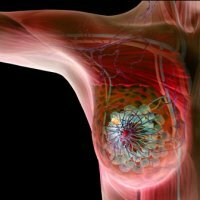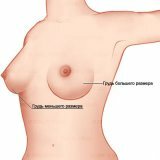Fibrous-cystic mastopathy of the breast

Fibro-cystic mastopathy is mainly influenced by women from thirty to fifty years of age. In women in post-menopausal age, this disease is less common.
The disease can manifest itself in many ways.
Sometimes the symptoms of fibrocystic mastopathy are so weak that the woman herself during self-examination, and the doctor on the examination of them can not pay attention. In addition, unpleasant sensations can disturb a woman not always, but only at a certain time, usually before menstruation. In other cases, women experience constant and severe pain, and in the mammary gland significant seals and tubercles are felt.
The term FCM.
Fibrocystic breast mastitis and fibrocystic disease are one and the same, but the first term( as well as the abbreviation FCM) is now more common.
Sometimes this disease is also called chronic cystic mastitis, mammary dysplasia, diffuse cystic mastopathy, benign breast tumor. The latter term denotes other benign breast formations.
It should be in any case to understand that the FCM - strictly speaking, not a disease, but a condition.
That is amazed at FCM.
In fibrocystic mastopathy, the glandular tissue of the breast is affected, the function of which is the production of milk. The glandular tissue, from which the breast is mainly composed, is surrounded by supporting elements and adipose tissue. The composition of the glandular tissue includes secretory cells responsible for the allocation of milk, and epithelial cells lining the surface of the secretory.
What caused the appearance of PCM.
The emergence of fibrocystic mastopathy is most likely due to the hormonal background of a woman during the menstrual cycle, in particular, the fluctuation in the level of estrogen and progesterone - the hormones responsible for the possibility of becoming pregnant. Both these hormones cause mammary gland cells to grow and multiply.
In addition to estrogen and progesterone, prolactin, insulin, thyroid hormone, growth hormone and others influence the development of PCM.And the mammary gland itself produces hormonal products from cells of fatty and glandular tissues. These products emit signals reaching other closely located cells of the breast;these signals can provoke the development of fibrocystic mastopathy.
How does the disease develop?
For lactation and for the course of the menstrual cycle, essentially the same hormones respond, but the processes occurring under their influence in the uterus and in the mammary gland are completely different.
In the uterus, due to the action of these hormones, cells lining the uterine cavity are actively growing and dividing.
These same hormones increase the growth rate of cells of the glandular tissue of the breast, affect the supporting tissues and blood vessels of the breast. These changes sometimes cause a woman during menstruation feeling full of mammary glands.
"Not useful" cells lining the cavity of the uterus, if the pregnancy has not occurred, are excreted from the body during menstruation."Extra" cells of the breast can not leave the body as easily. For their destruction by nature, apoptosis is envisaged( the process of programmed cell death);Activated enzymes promote the decay of cells, after which the cellular fragments are removed through the work of inflammatory( purifying) and glandular cells.
With apoptosis, there is a possibility of fibrosis( scarring), which adversely affects the glandular tissue and capillaries of the breast. Also, hormone-like substances produced by inflammatory cells and fragments of decayed cells can influence the glandular, supporting and flowing cells.
The flow of the purification process, the amount of cellular degradation products formed at the same time, the level of inflammation - all this is very individual and different in different months.
Fibrous-cystic mastopathy is most often observed in women with maternal cell disease. Also have to the fibrocystic mastopathy of a malfunction in the activity of the thyroid gland and liver, various inflammations of the genital organs, considerable mental stress.
Usually, this mastopathy of the breast is bilateral and entails pathological changes in the two mammary glands. Sometimes the condition of one of the glands may be more severe, but over time the percentage of fibrous tissue in both mammary glands becomes the same.
What is the risk of fibrocystic mastopathy?
Fibro-cystic mastopathy is not considered life threatening, but it can cause the development of breast cancer. Seals and tubercles observed in PCM are very similar to cancerous tumors. That is why it is so important for a woman to consult a mammalogist in time to diagnose the PCF with his help and keep a close eye on her, if necessary and even the slightest doubt, by conducting examinations to identify malignant tumors in the mammary gland.



